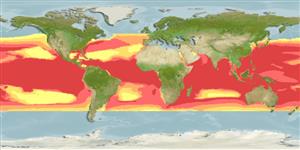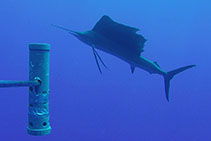Istiophorus platypterus (Shaw, 1792)
Indo-Pacific sailfish
Waarneming toevoegen in Fish Watcher
| Native range | All suitable habitat | Point map | Year 2050 |

|
| This map was computer-generated and has not yet been reviewed. |
| Istiophorus platypterus AquaMaps Data sources: GBIF OBIS |
Uploaden van uw Foto's en video's
Pictures | Stamps, coins, misc. | Google afbeeldingIstiophorus platypterus
Picture by University of Western Australia (UWA)
Pictures | Stamps, coins, misc. | Google afbeeldingIstiophorus platypterus
Picture by University of Western Australia (UWA)
Korea (South) country information
Common names:
Dot-sae-chi, 돛새치
Occurrence: native
Salinity: marine
Abundance: | Ref:
Importance: | Ref:
Aquaculture: | Ref:
Regulations: | Ref:
Uses: no uses
Comments: Also Ref. 43.
National Checklist:
Country Information: https://www.cia.gov/library/publications/resources/the-world-factbook/geos/ks.html
National Fisheries Authority:
Occurrences: Occurrences Point map
Main Ref: Kim, I.S., Y. Choi, C.L. Lee, Y.J. Lee, B.J. Kim and J.H. Kim, 2005
National Database:
Occurrence: native
Salinity: marine
Abundance: | Ref:
Importance: | Ref:
Aquaculture: | Ref:
Regulations: | Ref:
Uses: no uses
Comments: Also Ref. 43.
National Checklist:
Country Information: https://www.cia.gov/library/publications/resources/the-world-factbook/geos/ks.html
National Fisheries Authority:
Occurrences: Occurrences Point map
Main Ref: Kim, I.S., Y. Choi, C.L. Lee, Y.J. Lee, B.J. Kim and J.H. Kim, 2005
National Database:
Common names from other countries
Classificatie / Names Lokale namen | Synoniemen | Catalog of Fishes(Genus, Soort(en)) | ITIS | CoL | WoRMS | Cloffa
> Carangiformes (Jacks) > Istiophoridae (Billfishes)
Etymology: Istiophorus: Greek, istios = sail + Greek, pherein = to carry (Ref. 45335).
More on author: Shaw.
Etymology: Istiophorus: Greek, istios = sail + Greek, pherein = to carry (Ref. 45335).
More on author: Shaw.
Environment: milieu / climate zone / depth range / distribution range Ecologie
marien; oceanodroom (Ref. 51243); diepte 0 - 200 m (Ref. 54238), usually 30 - ? m (Ref. 9688). Subtropical; 50°N - 43°S, 180°W - 180°E (Ref. 43)
Verspreiding Landen | FAO regio's | Ecosystemen | Voorkomen | Point map | Introducties | Faunafri
Indo-Pacific: tropical and temperate waters approximately 45°- 50°N and 40°-35°S in the western Pacific, 35°N and 35°S in the eastern Pacific; 45°S in western Indian Ocean and 35°S in eastern Indian Ocean. Entered Mediterranean Sea from Red sea via Suez Canal. Highly migratory species. Some authors recognize a single worldwide species, Istiophorus platypterus (Shaw & Nodder 1792) but we follow Nakamura 1990 (Ref. 10820) retaining the usage of Istiophorus platypterus for the Indo-Pacific sailfish and Istiophorus albicans for the Atlantic sailfish in recognition of the differences between them.
Grootte / Gewicht / Leeftijd
Maturity: Lm ? range ? - 150 cm
Max length : 348 cm FL mannelijk / geslacht onbekend; (Ref. 40637); common length : 270 cm TL mannelijk / geslacht onbekend; (Ref. 9308); max. gepubliceerd gewicht: 100.2 kg (Ref. 40637); max. gerapporteerde leeftijd: 13 Jaren (Ref. 53742)
Max length : 348 cm FL mannelijk / geslacht onbekend; (Ref. 40637); common length : 270 cm TL mannelijk / geslacht onbekend; (Ref. 9308); max. gepubliceerd gewicht: 100.2 kg (Ref. 40637); max. gerapporteerde leeftijd: 13 Jaren (Ref. 53742)
Korte beschrijving Determinatiesleutels | Morfologie | Morfometrie
Dorsale stekels (totaal) : 0; Dorsale zachte stralen (totaal) : 47 - 53; Anale stekels: 2; Anale zachte stralen: 12 - 15. This species is distinguished by the following characters: slender elongate and fairly compressed with a high, sail-like first dorsal fin; upper jaw prolonged into a very long beak, slender and round in cross-section; jaws and palatines with villiform teeth; no gill rakers; two dorsal fins, the first very large (42-49 rays) the second small (6-7 rays); pectoral fins 18-20 rays; pelvic fins I, 2 soft rays fused together, very long and narrow, depressible into a groove; caudal peduncle with double keels on each side; body covered with small, embedded scales with 1 or 2 blunt points. Colour of back dark with about 20 bluish vertical bars; belly pale silver; membrane of first dorsal fin blue- black with numerous dark spots; bases of first and second anal fins often tinged with silvery white; remaining fins blackish brown or dark blue (Ref. 43, 26938).
Oceanic and epipelagic species usually found above the thermocline. Most densely distributed in waters close to coasts and islands (Ref. 9688). Most likely schools by size. Undergoes spawning migrations in the Pacific. Feeds mainly on fishes, crustaceans and cephalopods. Caught mainly with longlines, set nets, and sometimes by trolling and harpooning from boats (Ref. 43). Utilized fresh, smoked and frozen; also used for sashimi and sushi; eaten broiled and baked (Ref. 9987).
Levenscyclus en paargedrag Maturiteit | Voortplanting | Paaien | Eieren | Fecunditeit | Larven
Seems to spawn throughout the year in tropical and subtropical waters of the Pacific with peak spawning occurring in the respective local summer seasons. Spawning occurs with males and females swimming in pairs or with two or three males chasing a single female (probably a mating behavior). The ripe ovarian eggs are about 0.85 mm in diameter and have a single oil globule; there are no structures on the vitalize membrane and the egg is transparent. Eggs shed from captured female in the Indian Ocean averaged 1.304 mm in diameter.
Hoofdreferentie
Upload your references | Referenties | Coördinator | Medewerkers
Nakamura, I., 1985. FAO species catalogue. Vol. 5. Billfishes of the world. An annotated and illustrated catalogue of marlins, sailfishes, spearfishes and swordfishes known to date. FAO Fish. Synop. 125(5):65p. Rome: FAO. (Ref. 43)
Status op de Rode Lijst van het IUCN (Ref. 130435: Version 2024-2)
Kwetsbaar, zie IUCN Rode Lijst (VU) (A2bd); Date assessed: 01 May 2021
Gevaar voor de mens
Harmless
Gebruik door de mens
Visserij: commercieel; sportvis: ja
FAO(visserij: productie, soortsprofiel; publication : search) | FishSource | Sea Around Us
Meer informatie
Population dynamics
Groeiparameters
Max. ages / sizes
Length-weight rel.
Length-length rel.
Lengtefrequenties
Massaconversie
Rekrutering
Abundantie
Groeiparameters
Max. ages / sizes
Length-weight rel.
Length-length rel.
Lengtefrequenties
Massaconversie
Rekrutering
Abundantie
Life cycle
Voortplanting
Maturiteit
Fecunditeit
Paaien
Spawning aggregations
Eieren
Ontwikkeling van de eieren
Larven
Larvale populatiedynamiek
Voortplanting
Maturiteit
Fecunditeit
Paaien
Spawning aggregations
Eieren
Ontwikkeling van de eieren
Larven
Larvale populatiedynamiek
Physiology
Body composition
Nutrients
Zuurstofverbruik
Zwemtype
Zwemsnelheid
Visual pigments
Fish sound
Diseases & Parasites
Toxicity (LC50s)
Body composition
Nutrients
Zuurstofverbruik
Zwemtype
Zwemsnelheid
Visual pigments
Fish sound
Diseases & Parasites
Toxicity (LC50s)
Genetics
Genetica
Heterozygosity
Erfelijkheid
Genetica
Heterozygosity
Erfelijkheid
Human related
Aquaculture systems
Aquacultuurprofielen
Kweeklijnen
Ciguatera cases
Stamps, coins, misc.
Aquaculture systems
Aquacultuurprofielen
Kweeklijnen
Ciguatera cases
Stamps, coins, misc.
Tools
E-boek | Veldgids | Determinatiesleutels | Lengtefrequentie Tool | Levenscyclus tool | Verspreidingskaart | Classification Tree
| Catch-MSY |
Speciale rapporten
Bekijk gegevens voor het houden in een aquarium | Bekijk Fact Sheets voor de soort | Bekijk Aquacultuur Fact Sheets
Download XML
Internetbronnen
Aquatic Commons | BHL | Cloffa | BOLDSystems | Websites from users | Bekijk FishWatcher | CISTI | Catalog of Fishes(Genus, Soort(en)) | DiscoverLife | ECOTOX | Faunafri | Fishtrace | GenBank(genoom, nucleotide) | GloBI | GOBASE | GoMexSI (interaction data) | | Google Books | Google Scholar | Google | IGFA World Record | MitoFish | Nationale databanken | Otolith Atlas of Taiwan Fishes | PubMed | Reef Life Survey | Scirus | SeaLifeBase | Tree of Life | Wikipedia(ga naar, zoek) | World Records Freshwater Fishing | Zoological Record
Estimates based on models
Preferred temperature (Ref. 115969): 18.2 - 27.7, mean 25.6 (based on 513 cells).
Fylogenetische diversiteitsindex (Ref. 82804): PD50 = 0.7505 [Uniqueness, from 0.5 = low to 2.0 = high].
Bayesian length-weight: a=0.00589 (0.00273 - 0.01268), b=3.14 (2.94 - 3.34), in cm Total Length, based on LWR estimates for this species & (Sub)family-body (Ref. 93245).
Trofisch niveau (Ref. 69278): 4.5 ±0.3 se; based on diet studies.
Weerstandsvermogen (Ref. 120179): laag, minimale populatieverdubbelingstijd 4,5-14 jaar (rm=0.11; K=0.4-0.8; tmax=13; Fec=>2M).
Prior r = 0.38, 95% CL = 0.25 - 0.57, Based on 1 full stock assessment.
Fishing Vulnerability (Ref. 59153): Moderate vulnerability (41 of 100).
Climate Vulnerability (Ref. 125649): Moderate to high vulnerability (48 of 100).




